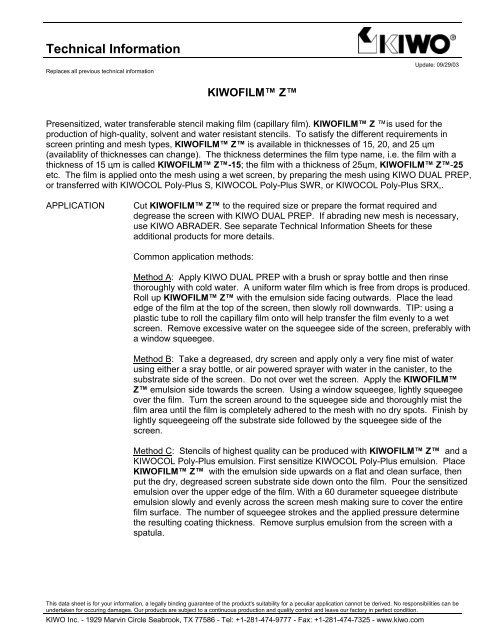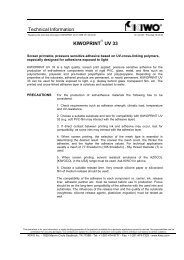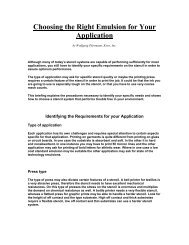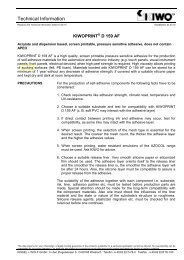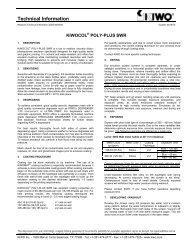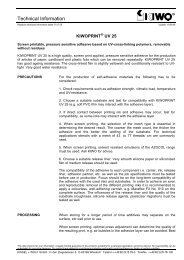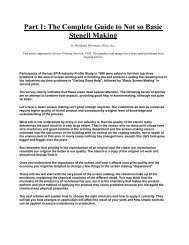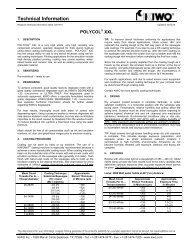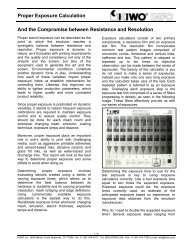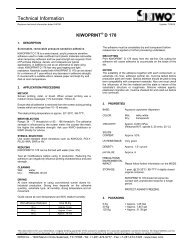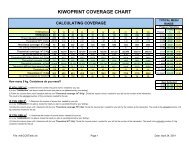Technical Information - KIWO
Technical Information - KIWO
Technical Information - KIWO
Create successful ePaper yourself
Turn your PDF publications into a flip-book with our unique Google optimized e-Paper software.
<strong>Technical</strong> <strong>Information</strong><br />
Replaces all previous technical information<br />
<strong>KIWO</strong>FILM Z<br />
Update: 09/29/03<br />
Presensitized, water transferable stencil making film (capillary film). <strong>KIWO</strong>FILM Z is used for the<br />
production of high-quality, solvent and water resistant stencils. To satisfy the different requirements in<br />
screen printing and mesh types, <strong>KIWO</strong>FILM Z is available in thicknesses of 15, 20, and 25 цm<br />
(availablity of thicknesses can change). The thickness determines the film type name, i.e. the film with a<br />
thickness of 15 цm is called <strong>KIWO</strong>FILM Z-15; the film with a thickness of 25цm, <strong>KIWO</strong>FILM Z-25<br />
etc. The film is applied onto the mesh using a wet screen, by preparing the mesh using <strong>KIWO</strong> DUAL PREP,<br />
or transferred with <strong>KIWO</strong>COL Poly-Plus S, <strong>KIWO</strong>COL Poly-Plus SWR, or <strong>KIWO</strong>COL Poly-Plus SRX,.<br />
APPLICATION Cut <strong>KIWO</strong>FILM Z to the required size or prepare the format required and<br />
degrease the screen with <strong>KIWO</strong> DUAL PREP. If abrading new mesh is necessary,<br />
use <strong>KIWO</strong> ABRADER. See separate <strong>Technical</strong> <strong>Information</strong> Sheets for these<br />
additional products for more details.<br />
Common application methods:<br />
Method A: Apply <strong>KIWO</strong> DUAL PREP with a brush or spray bottle and then rinse<br />
thoroughly with cold water. A uniform water film which is free from drops is produced.<br />
Roll up <strong>KIWO</strong>FILM Z with the emulsion side facing outwards. Place the lead<br />
edge of the film at the top of the screen, then slowly roll downwards. TIP: using a<br />
plastic tube to roll the capillary film onto will help transfer the film evenly to a wet<br />
screen. Remove excessive water on the squeegee side of the screen, preferably with<br />
a window squeegee.<br />
Method B: Take a degreased, dry screen and apply only a very fine mist of water<br />
using either a sray bottle, or air powered sprayer with water in the canister, to the<br />
substrate side of the screen. Do not over wet the screen. Apply the <strong>KIWO</strong>FILM<br />
Z emulsion side towards the screen. Using a window squeegee, lightly squeegee<br />
over the film. Turn the screen around to the squeegee side and thoroughly mist the<br />
film area until the film is completely adhered to the mesh with no dry spots. Finish by<br />
lightly squeegeeing off the substrate side followed by the squeegee side of the<br />
screen.<br />
Method C: Stencils of highest quality can be produced with <strong>KIWO</strong>FILM Z and a<br />
<strong>KIWO</strong>COL Poly-Plus emulsion. First sensitize <strong>KIWO</strong>COL Poly-Plus emulsion. Place<br />
<strong>KIWO</strong>FILM Z with the emulsion side upwards on a flat and clean surface, then<br />
put the dry, degreased screen substrate side down onto the film. Pour the sensitized<br />
emulsion over the upper edge of the film. With a 60 durameter squeegee distribute<br />
emulsion slowly and evenly across the screen mesh making sure to cover the entire<br />
film surface. The number of squeegee strokes and the applied pressure determine<br />
the resulting coating thickness. Remove surplus emulsion from the screen with a<br />
spatula.<br />
This data sheet is for your information, a legally binding guarantee of the product's suitability for a peculiar application cannot be derived. No responsibilities can be<br />
undertaken for occuring damages. Our products are subject to a continuous production and quality control and leave our factory in perfect condition.<br />
<strong>KIWO</strong> Inc. - 1929 Marvin Circle Seabrook, TX 77586 - Tel: +1-281-474-9777 - Fax: +1-281-474-7325 - www.kiwo.com
<strong>Technical</strong> <strong>Information</strong><br />
<strong>KIWO</strong>FILM Z<br />
Page 2 of 3<br />
Update:09/29/03<br />
DRYING Screens should be dried thoroughly before exposing to achieve the highest printing<br />
resistance. A dust-free drying chamber at temperatures between 80°F to 100°F with<br />
relative humidity below 50% is recommended. Drying in high relative humidity<br />
environments, i.e. above 50%, may cause lower resistance levels to printing inks and<br />
mechanical wear. After drying, it is recommended to remove the backing film for<br />
further, complete drying.<br />
EXPOSURE The stencil is created by UV-light hardening the emulsion in the non-printing image<br />
areas. Expose at a wavelength of 350-420nm. A metal halide lamp provides the best<br />
results. Due to the many variables that determine the actual exposure time, it can<br />
best be determined through testing using the <strong>KIWO</strong> ExpoCheck exposure calculator.<br />
For best durability, please choose an exposure time that is as long as possible without<br />
loosing fine details in the image.<br />
*Values for average exposure times listed in seconds using a 5,000 W metal halide lamp at a<br />
distance of 40 inches. Exposure units vary considerably and proper testing using an exposure<br />
calculator like our <strong>KIWO</strong> ExpoCheck is the best way to determine optimum, complete exposure.<br />
<strong>KIWO</strong>FILM<br />
<br />
Z series<br />
type<br />
Z-15<br />
Z-20<br />
Z-25<br />
Yellow<br />
Polyester<br />
Mesh<br />
TPI – thread<br />
diameter<br />
380 – 31 Y<br />
305 – 34 Y<br />
380 – 31 Y<br />
305 – 34 Y<br />
260 – 40 Y<br />
260 – 40 Y<br />
195 – 55 Y<br />
Average exposure time*<br />
Water Emulsion<br />
Transfer Transfer<br />
45 s<br />
50 s<br />
50 s<br />
55 s<br />
60 s<br />
170 s<br />
185 s<br />
110 s<br />
120 s<br />
130 s<br />
150 s<br />
170 s<br />
325 s<br />
375 s<br />
All above values determined using the same working procedures. Values may change depending on your specific<br />
working procedures. Testing is required to determine specific values for your application.<br />
RETOUCHING/ For retouching/blocking-out use solvent resistant products<br />
BLOCKING-OUT like the <strong>KIWO</strong> BLOCKOUT or <strong>KIWO</strong> RED BLOCKOUT. See separate <strong>Technical</strong><br />
<strong>Information</strong> Sheets for these products for more details.<br />
RECLAMING <strong>KIWO</strong>FILM Z can easily be reclaimed with <strong>KIWO</strong> STENCIL REMOVER 1:20<br />
and a high-pressure water washer. When using thicker mesh types it is
<strong>Technical</strong> <strong>Information</strong><br />
<strong>KIWO</strong>FILM Z<br />
Page 3 of 3<br />
Update:09/29/03<br />
recommended to spray out from the squeegee side. So-called ghost, haze images<br />
or ink residue which may remain on the screen after reclaiming and can be removed<br />
from the screen using haze removing products such as <strong>KIWO</strong> MEGA CLEAN<br />
ACTIVE, <strong>KIWO</strong> HAZE REMOVER or PREGAN PASTE. For optimum stain<br />
removing, activate <strong>KIWO</strong> HAZE REMOVER and PREGAN PASTE with one of our<br />
ink degradents such as <strong>KIWO</strong> INK WASH, <strong>KIWO</strong> EXCEL INK WASH or <strong>KIWO</strong><br />
ULTIMATE INK WASH. These products help boost the ink haze removing ability of<br />
the haze removing products mentioned above. See separate <strong>Technical</strong> <strong>Information</strong><br />
Sheets for these additional products for more details.<br />
NOTICE Please note that the printing resistance of a screen printing stencil is influenced by<br />
various parameters which have not been tested by us. Therefore please accept our<br />
offer to test the suitability of <strong>KIWO</strong>FILM Z for your specific application by<br />
asking for samples: 1-800-<strong>KIWO</strong>-USA or www.kiwo.com.<br />
COLOR Unexposed: green<br />
Exposed: blue<br />
HEALTH HAZARDS/ Please follow further information given in the Material Safety Data<br />
ENVIRONMENTAL Sheet (MSDS).<br />
PROTECTION<br />
STORAGE 12 months (at max. 75ºF and in original packaging unit)<br />
Screens coated in advance: appox. 14 days at 70°F and in complete darkness.<br />
With longer storage of precoated screens the copying material can absorb humidity<br />
from the environment. Therefore, It is advisable to dry again prior to exposing.<br />
ADDITIONAL For additional product information, please visit our web site at<br />
INFORMATION www.kiwo.com. All products mentioned in this <strong>Technical</strong> <strong>Information</strong> Sheet are<br />
available through <strong>KIWO</strong> Inc. and its distributor network. For further information<br />
contact your <strong>KIWO</strong> distributor, or <strong>KIWO</strong> direct.<br />
Thank you for choosing <strong>KIWO</strong>.<br />
Any information pertaining to this product should be considered confidental and<br />
communicated to <strong>KIWO</strong>, or your <strong>KIWO</strong> distributor.


